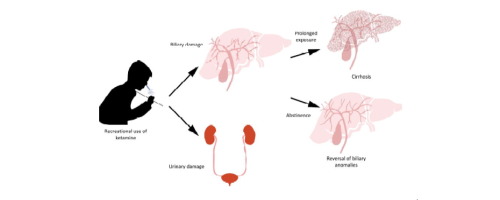当前位置:
X-MOL 学术
›
J. Hepatol.
›
论文详情
Our official English website, www.x-mol.net, welcomes your feedback! (Note: you will need to create a separate account there.)
Magnetic resonance cholangiogram patterns and clinical profiles of ketamine-related cholangiopathy in drug users
Journal of Hepatology ( IF 25.7 ) Pub Date : 2018-07-01 , DOI: 10.1016/j.jhep.2018.03.006 Wai-Kay Seto , Siu-King Mak , Keith Chiu , Varut Vardhanabhuti , Ho-Fai Wong , Heng-Tat Leong , Paul S.F. Lee , Y.C. Ho , Chi-Kei Lee , Ka-Shing Cheung , Man-Fung Yuen , Wai K. Leung
Journal of Hepatology ( IF 25.7 ) Pub Date : 2018-07-01 , DOI: 10.1016/j.jhep.2018.03.006 Wai-Kay Seto , Siu-King Mak , Keith Chiu , Varut Vardhanabhuti , Ho-Fai Wong , Heng-Tat Leong , Paul S.F. Lee , Y.C. Ho , Chi-Kei Lee , Ka-Shing Cheung , Man-Fung Yuen , Wai K. Leung

|
BACKGROUND & AIMS
Recreational ketamine use has emerged as an important health and social issue worldwide. Although ketamine is associated with biliary tract damage, the clinical and radiological profiles of ketamine-related cholangiopathy have not been well described. METHODS
Chinese individuals who had used ketamine recreationally at least twice per month for six months in the previous two years via a territory-wide community network of charitable organizations tackling substance abuse were recruited. Magnetic resonance cholangiography (MRC) was performed, and the findings were interpreted independently by two radiologists, with the findings analysed in association with clinical characteristics. RESULTS
Among the 343 ketamine users referred, 257 (74.9%) were recruited. The mean age and ketamine exposure duration were 28.7 (±5.8) and 10.5 (±3.7) years, respectively. A total of 159 (61.9%) had biliary tract anomalies on MRC, categorized as diffuse extrahepatic dilatation (n = 73), fusiform extrahepatic dilatation (n = 64), and intrahepatic ductal changes (n = 22) with no extrahepatic involvement. Serum alkaline phosphatase (ALP) level (odds ratio [OR] 1.007; 95% CI 1.002-1.102), lack of concomitant recreational drug use (OR 1.99; 95% CI 1.11-3.58), and prior emergency attendance for urinary symptoms (OR 1.95; 95% CI 1.03-3.70) had high predictive values for biliary anomalies on MRC. Among sole ketamine users, ALP level had an AUC of 0.800 in predicting biliary anomalies, with an optimal level of ≥113 U/L having a positive predictive value of 85.4%. Cholangiographic anomalies were reversible after ketamine abstinence, whereas decompensated cirrhosis and death were possible after prolonged exposure. CONCLUSIONS
We have identified distinctive MRC patterns in a large cohort of ketamine users. ALP level and lack of concomitant drug use predicted biliary anomalies, which were reversible after abstinence. The study findings may aid public health efforts in combating the growing epidemic of ketamine abuse. LAY SUMMARY
Recreational inhalation of ketamine is currently an important substance abuse issue worldwide, and can result in anomalies of the biliary system as demonstrated by magnetic resonance imaging. Although prolonged exposure may lead to further clinical deterioration, such biliary system anomalies might be reversible after ketamine abstinence. Clinical trial number: NCT02165488.
更新日期:2018-07-01



























 京公网安备 11010802027423号
京公网安备 11010802027423号